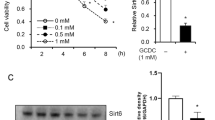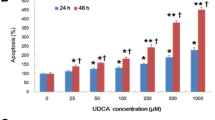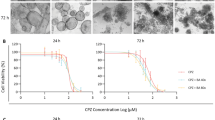Abstract
Bile duct epithelium is physiologically exposed to high concentrations of bile salts, suggesting the presence of a cytoprotective mechanism(s). The aim of this study was to clarify whether bile salts cause bile duct cell damage and to elucidate the mechanism(s) providing protection against such an action of bile salts. Immortalized mouse cholangiocytes were incubated with taurocholate, taurochenodeoxycholate, glycochenodeoxycholate (GCDC), taurodeoxycholate, and tauroursodeoxycholate (TUDC), followed by flow-cytometric analysis and caspase activity assay to evaluate the induction of apoptosis. GCDC time-dependently induced caspase 3 (3.4-fold)- and caspase 9 (1.4-fold)-mediated apoptosis of cholangiocytes, but this was inhibited by lecithins and TUDC. Further, expression of cholangiocyte bile salt transporters (apical sodium-dependent bile salt transporter [Asbt] and multidrug resistance protein 3 [Mrp3]) was examined by RT-PCR and western blotting, and cholangiocyte bile salt uptake was determined using radiolabeled bile salts. Expression of cholangiocyte Asbt and Mrp3 was increased by bile salts, whereas lecithins interestingly reduced bile salt uptake to inhibit cholangiocyte apoptosis. In conclusion, bile salts themselves cause cholangiocyte apoptosis when absorbed by and retained inside the cell, but this is inhibited by washing out cytotoxic bile salts according to Mrp3, a rescue exporting molecule. Biliary lecithin is seemingly another cytoprotective player against cytotoxic bile salts, reducing their uptake, and this is associated with a reduced expression of Mrp3.
Similar content being viewed by others
References
O'Connor CJ, Wallence RG, Iwamoto K, Taguti T, Sunamoto J: Bile salt damage of egg phosphatidylcholine liposomes. Biochim Biophys Acta 817:95-102, 1985
Sagawa H, Tazuma S, Kajiyama G: Protection against hydrophobic bile salt-induced cell membrane damage by liposomes and hydrophilic bile salts. Am J Physiol 264:G835-G839, 1993
Faubion WA, Guicciardi ME, Miyoshi H, Bronk SF, Roberts PJ, Svingen PA, Kaufmann SH, Gores GJ: Toxic bile salts induce rodent hepatocyte apoptosis via direct activation of Fas. J Clin Invest 103:137-145, 1999
Yerushalmi B, Dahl R, Devereaux MW, Gumpricht E, Sokol RJ: Bile acid-induced rat hepatocytes apoptosis is inhibited by antioxidants and blockers of the mitochondrial permeability transition. Hepatology 33:616-626, 2001
Sokol RJ, Winkholer-Roob BM, Devereaux MW, McKim JM: Generation of hydroperoxides in isolated rat hepatocytes and hepatic mitochondria exposed to hydrophobic bile acids. Gastroenterology 109:1249-1256, 1995
Galle PR, Theilmann L, Raedsch R, Otto G, Stiehl A: Ursodeoxycholate reduces hepatotoxicity of bile salts in primary human hepatocytes. Hepatology 12:486-491, 1990
Patel T, Bronk SF, Gores GJ: Increases of intracellular magnesium promote glycodeoxycholate-induced apoptosis in rat hepatocytes. J Clin Invest. 94:2183-2192, 1994
Gumpricht E, Devereaux MW, Dahl RH, Sokol RJ: Glutathione status of isolated rat hepatocytes affects bile acid-induced cellular necrosis but not apoptosis. Toxicol Appl Pharmacol. 164:102-111, 2000
Rodrigues CM, Fan G, Ma X, Kren BT, Steer CJ: A novel role for ursodeoxycholic acid in inhibiting apoptosis by modulating mitochondrial membrane perturbation. J Clin Invest. 101:2790-2799, 1998
Jones BA, Rao YP, Stravitz RT, Gores GJ: Bile salt-induced apoptosis of hepatocytes involves activation of protein kinase C. Am J Physiol. 272:G1109-G1115, 1997
Owen RW: Faecal steroids and colorectal carcinogenesis. Scand J Gastroenterol 222 (Suppl):76-82, 1997
Reddy BS, Watanabe K, Weisburger JH, Wynder EL: Promoting effects of bile acids in colon carcinogenesis in germfree and conventional F344 rats. Cancer Res 37:3238-3242, 1977
Hori T, Matsumoto K, Sakaitani Y, Sato M, Morotomi M: Effect of dietary deoxycholic acid and cholesterol on fecal steroid concentration and its impact on the colonic crypt cell proliferation in azoxymethane-treated rats. Cancer Lett 124:79-84, 1998
Schlottmann K, Wachs FP, Krieg RC, Kullmann F, Schölmerich J, Rogler G: Characterization of bile salt-induced apoptosis in colon cancer cell lines. Cancer Res 60:4270-4276, 2000
Powell AA, Larue JM, Batta AK, Martinez JD: Bile acid hydrophobicity is correlated with induction of apoptosis and/or growth arrest in HCT116 cells. Biochem J 356:481-486, 2001
Mano Y, Ishii M, Kisara N, Kobayashi K, Hamada H, Toyota T: Duct formation by immortalized mouse cholangiocytes: an in vitro model for cholangiopathies. Lab Invest 78:1467-1468, 1998
Saeki T, Matoba K, Furukawa H, Kirifuji K, Kanamoto R, Iwami K: Characterization, cDNA cloning, and functional expression of mouse ileal sodium-dependent bile acid transporter. J Biochem (Tokyo) 125:846-851, 1999
Schuetz EG, Strom S, Yasuda K, Lecureur V, Assem M, Brimer C, Lamba J, Kim RB, Ramachandran V, Komoroski BJ, Venkataramanan R, Cai H, Sinal CJ, Gonzalez FJ, Schuetz JD: Disrupted bile acid homeostasis reveals an unexpected interaction among nuclear hormone receptors, transporters, and cytochrome P450. J Biol Chem 276:39411-39418, 2001
Hanaka S, Abe T, Itakura H, Matsumoto A: Gene expression related to cholesterol metabolism in mouse brain during development. Brain Dev 22:321-326, 2000
Takikawa Y, Miyoshi H, Rust C, Roberts P, Siegel R, Mandal PK, Millikan RE, Gores GJ: The bile acid-activated phosphatidylinositol 3-kinase pathway inhibits Fas apoptosis upstream of bid in rodent hepatocytes. Gastroenterology 120:1810-1817, 2001
Waters E, Wang JH, Redmond HP, Wu QD, Kay E, Bouchier-Hayes D: Role of taurine in preventing acetaminophen-induced hepatic injury in the rat. Am J Physiol Gastrointest Liver Physiol 280:G1274-G1279, 2001
Wu QD, Wang JH, Fennessy F, Redmond HP, Bouchier-Hayes D: Taurine prevents high-glucose-induced human vascular endothelial cell apoptosis. Am J Physiol 277:C1229-C1238, 1999
Huxtable RJ: Physiological actions of taurine. Physiol Rev 72:101-163, 1992
Chen YX: Protective action of taurine on ischemia-reperfusion liver injury in rats and its mechanisms. Chin Med J 73:276-279, 1993
Milei J, Ferreira R, Llesuy S, Forcada P, Covarrubias J, Boveris A: Reduction of reperfusion injury with preoperative rapid intravenous infusion of taurine during myocardial revascularization. Am Heart J 123:339-345, 1992
Aihara N, Tazuma S, Kajiyama G: Hydrophilic bile salts and liposomes inhibit hydrophobic bile salt-induced release of glycoprotein by guinea-pig gall-bladder. J Gastroenterol Hepatol 10:42-46, 1995
Marucci L, Alpini G, Glaser SS, Alvaro D, Benedetti A, Francis H, Phinizy JL, Marzioni M, Mauldin J, Venter J, Baumann B, Ugili L, LeSage G: Taurocholate feeding prevents CCl4-induced damage of large cholangiocytes through PI3-kinase-dependent mechanism. Am J Physiol Gastrointest Liver Physiol 284:G290-G301, 2003
Alpini G, Baiocchi L, Glaser S, Ueno Y, Marzioni M, Francis, H Phinizy JL, Angelico M, Lesage G: Ursodeoxycholate and tauroursodeoxycholate inhibit cholangiocyte growth and secretion of BDL rats through activation of PKC alpha. Hepatology 35:1041-1052, 2002
Chignard N, Mergey M, Veissiere D, Parc R, Capeau J, Poupon R, Paul A, Housset C: Bile acid transport and regulating functions in the human biliary epithelium. Hepatology 33:496-503, 2001
Lazaridis KN, Pham L, Tietz P, Marinelli RA, deGroen PC, Levine S, Dawson PA, LaRusso NF: Rat cholangiocytes absorb bile acids at their apical domain via the ileal sodium-dependent bile acid transporter. J Clin Invest 100:2714-2721, 1997
Kool M, van der Linden M, de Haas M, Scheffer GL, de Vree JM, Smith AJ, Jansen G, Peters GJ, Ponne N, Scheper RJ, Elferink RP, Baas F, Borst P: MRP3, an organic anion transporter able to transport anti-cancer drugs. Proc Natl Acad Sci USA 96:6914-6919, 1999
Soroka CJ, Lee JM, Azzaroli F, Boyer JL: Cellular localization and up-regulation of multidrug resistance-associated protein 3 in hepatocytes and cholangiocytes during obstructive cholestasis in rat liver. Hepatology 33:783-791, 2001
Chianale J, Vollrath V, Wielandt AM, Amigo L, Rigotti A, Nervi F, Gonzalez S, Andrade L, Pizarro M, Accatino L. Fibrates induce mdr2 gene expression and biliary phospholipid secretion in the mouse. Biochem J 314:781-786, 1996
Miyaguchi S, Ebinuma H, Imaeda H, Nitta Y, Watanabe T, Saito H, Ishii H: A novel treatment for refractory primary biliary cirrhosis? Hepatogastroenterology 47:1518-1521, 2000
Author information
Authors and Affiliations
Corresponding author
Rights and permissions
About this article
Cite this article
Komichi, D., Tazuma, S., Nishioka, T. et al. Unique Inhibition of Bile Salt-Induced Apoptosis by Lecithins and Cytoprotective Bile Salts in Immortalized Mouse Cholangiocytes. Dig Dis Sci 48, 2315–2322 (2003). https://doi.org/10.1023/B:DDAS.0000007869.67105.27
Issue Date:
DOI: https://doi.org/10.1023/B:DDAS.0000007869.67105.27




